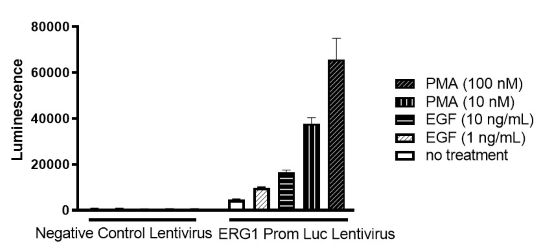78664
EGR1 Promoter Luciferase Reporter Lentivirus
BPS Bioscience
DESCRIPTION
The Early growth response 1 (EGR1, also known as ZNF268 or NGFi-A) Promoter Luciferase Reporter Lentiviruses are replication incompetent, HIV-based, VSV-G pseudotyped lentiviral particles that are ready to be transduced into almost all types of mammalian cells, including primary and non-dividing cells. The particles contain a firefly luciferase gene driven by the human EGR1 promoter (~1.3 kb, Figure 1). After transduction, activation of the EGR1 promoter in the target cells can be monitored by measuring the luciferase activity.
Figure 1. Schematic of the lenti-vector used to generate the EGR1 Promoter Luciferase Reporter Lentivirus.
DETAILS
- Notes: To generate an ERG1 promoter luciferase reporter stable cell line, remove the growth medium 48 hours after transduction and replace it with fresh growth medium containing the appropriate amount of puromycin for antibiotic selection of transduced cells. The following Lentivirus Reporter Controls are available from BPS Bioscience to meet your experimental needs: Negative Control Luciferase Lentivirus (BPS Bioscience #79578): Ready-to-transduce lentiviral particles expressing firefly luciferase under the control of a minimal promoter. The negative control is important to establish the specificity of any treatment and to determine the background reporter activity. Renilla Luciferase Lentivirus (BPS Bioscience #79565): Ready-to-transduce lentiviral particles expressing Renilla luciferase under the CMV promoter. The RLuc lentivirus can serve as an internal control to overcome sample-to-sample variability when performing dual-luciferase reporter assays. Firefly Luciferase Lentivirus (BPS Bioscience #79692-G, #79692-H, #79692-P): Ready-to-transduce lentiviral particles expressing firefly luciferase under the CMV promoter. It serves as a positive control for transduction optimization studies. Biosafety: The lentiviruses are produced with the third generation SIN (self-inactivation) lentivector which ensures self-inactivation of the lentiviral construct after transduction and integration into the genomic DNA of the target cells. None of the HIV genes (gag, pol, rev) will be expressed in the transduced cells, as they are expressed from packaging plasmids lacking the packing signal and are not present in the lentivirus particle. Although the pseudotyped lentiviruses are replication-incompetent, they require the use of a Biosafety Level 2 facility. BPS Bioscience recommends following all local federal, state, and institutional regulations and using all appropriate safety precautions. Troubleshooting Guide: Visit bpsbioscience.com/lentivirus-faq for detailed troubleshooting instructions. For all further questions, please email support@bpsbioscience.com.
- Shiptemp: -80°C (dry ice)
- Warnings: Avoid freeze/thaw cycles
- Category: Apoptosis/Lentivirus
- Background: Early growth response factor 1 (EGR1) is a member of the EGR family and an important transcription factor. It contains an activation regulatory region, a repressive regulatory region, and three Cys2-His2 subclass zinc finger structures, all recognizing and binding target genes and regulating their transcription. Widely expressed in many different cell types, EGR1 is important in many physiological processes, including cell proliferation and inflammatory factors. EGR1 is a key molecule implicated in many signaling pathways and can act as a tumor suppressor to help monitor DNA damage. It can also promote tumor cell apoptosis and enhance the anticancer effects of radiotherapy and chemotherapy. Alternatively, increased EGR1 expression in hypoxic microenvironments will maintain tumor cell survival and proliferation. Researching the mechanisms of action of EGR1 can help study potential cancer therapies and new cancer treatment studies.
- Description: The Early growth response 1 (EGR1, also known as ZNF268 or NGFi-A) Promoter Luciferase Reporter Lentiviruses are replication incompetent, HIV-based, VSV-G pseudotyped lentiviral particles that are ready to be transduced into almost all types of mammalian cells, including primary and non-dividing cells. The particles contain a firefly luciferase gene driven by the human EGR1 promoter (~1.3 kb, Figure 1). After transduction, activation of the EGR1 promoter in the target cells can be monitored by measuring the luciferase activity. Figure 1. Schematic of the lenti-vector used to generate the EGR1 Promoter Luciferase Reporter Lentivirus.
- Formulation: The lentivirus particles were produced from HEK293T cells. They are supplied in cell culture medium containing 90% DMEM + 10% FBS.
- Supplied As: Two vials (500 µl x 2) of lentivirus at a titer >107 TU/ml. The titer will vary with each lot; the exact value will be provided with each shipment.
- Unspsc Code: 41106621
- Unspsc Name: Virus mediated expression vectors or kits
- Applications: Screen for activators or inhibitors of EGR1 promoter activity in transduced cells. Generation of an EGR1 promoter luciferase reporter stable cell line (puromycin resistant).
- Product Type: Lentivirus
- Biosafety Level: BSL-2
- Related Products: 90201-1, 60187, 78672, 78745
- Storage Stability: Lentiviruses are shipped with dry ice. For long-term storage, it is recommended to store the lentiviruses at -80°C.
- Scientific Category: Apoptosis
